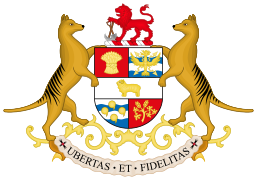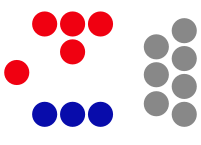Parliament of Tasmania
The Parliament of Tasmania is the bicameral legislature of the Australian state of Tasmania. It follows a Westminster-derived parliamentary system and consists of the Governor of Tasmania, the Tasmanian House of Assembly (the lower house), and Tasmanian Legislative Council (the upper house).[2] Since 1841, both Houses have met in Parliament House, Hobart. The Parliament of Tasmania first met in 1856.
Parliament of Tasmania | |
|---|---|
 | |
 | |
| Type | |
| Type | |
| Houses | Legislative Council House of Assembly |
| History | |
| Founded | 2 December 1856 |
| Leadership | |
Kate Warner since 10 December 2014 | |
| Structure | |
| Seats | 40 25 MHAs 15 MLCs |
 | |
House of Assembly political groups | Government Liberal (13) Opposition Labor (10) Crossbench Greens (2) Independent (1) |
 | |
Legislative Council political groups | Government Liberal (2) Opposition Labor (4) Crossbench Independent (9)[lower-alpha 1] |
| Elections | |
| Hare-Clark | |
| Instant-runoff voting | |
Last general election | 3 March 2018 |
Next general election | by 2022 |
| Meeting place | |
 | |
| Parliament House, Hobart, Tasmania, Australia | |
| Website | |
| www.parliament.tas.gov.au | |
The powers of the Parliament are prescribed in the Constitution of Tasmania, as amended from time to time. Since the Federation of Australia in 1901, Tasmania has been a state of the Commonwealth of Australia, and the Constitution of Australia regulates its relationship with the Commonwealth. Under the Australian Constitution, Tasmania ceded certain legislative and judicial powers to the Commonwealth, but retained complete independence in all other areas. In practice, however, the independence of the Australian states has been greatly eroded by the increasing financial domination of the Commonwealth.
The leader of the party or coalition with the confidence of the House of Assembly is invited by the Governor to form the Government and become Premier of Tasmania.
History
The island of Van Diemen's Land (now known as Tasmania) was claimed and subsequently settled by Great Britain in 1803. Initially, it was administered by the Governor of New South Wales, as part of that British Colony of New South Wales. In 1825, Van Diemen's Land became a separate British colony, administered separately from New South Wales, with a Legislative Council of six men appointed to advise the Lieutenant Governor of Van Diemen's Land who had sole governance of the colony. The Council initially held meetings in a room adjacent to the old Government House that was located near to the present site of Franklin Square, but by 1841 they relocated meetings to the 'Long Room' (now the Members' Lounge) in the Customs House.[3]
In 1850, the British Parliament enacted the Australian Colonies Government Act, which gave Van Diemen's Land the right to elect its first representative government. The size of the Legislative Council was increased from six to 24. Eight members were appointed by the Governor, and 16 were elected by property owners. The new Legislative Council met for the first time in 1852, and by 1854 they had passed the Tasmanian Constitution Act, giving Van Diemen's Land responsible self-government and a new bicameral parliament. Queen Victoria granted Royal assent in 1855 and Van Diemen's Land became a self-governing colony. In the following year, 1856, one of the new parliament's first acts was to change the name of the colony from Van Diemen's Land to Tasmania.
Houses of Parliament
House of Assembly
The Tasmanian House of Assembly is the lower house of the Tasmanian Parliament. There are 25 members, with five members elected from each of the 5 divisions. The divisions are: Bass, Braddon, Denison, Franklin, and Lyons. The Tasmanian House of Assembly electoral divisions share the same names and boundaries as the Australian House of Representatives divisions for Tasmania.
Members are elected using the Hare-Clark voting system of multi-member proportional representation for a term of up to 4 years.
Current distribution of seats
The distribution of seats as a result of the 2018 state election is:
| Party | Seats held | Percentage | Seat distribution | ||||||||||||||||||||||||
|---|---|---|---|---|---|---|---|---|---|---|---|---|---|---|---|---|---|---|---|---|---|---|---|---|---|---|---|
| Liberal Party | 13 | 52% | |||||||||||||||||||||||||
| Labor Party | 10 | 40% | |||||||||||||||||||||||||
| Tasmanian Greens | 2 | 8% | |||||||||||||||||||||||||
Legislative Council
The Tasmanian Legislative Council is the upper house of the Tasmanian Parliament. It has 15 members, each elected from a single-member electoral division. The boundaries of the divisions are reviewed by tribunal every 9 years.[4]
Elections are conducted annually on a 6-year periodic cycle; 3 divisions will be up for election in May one year, then 2 divisions in May the following year and so on. As such, each member will normally serve a term of 6 years.
Current distribution of seats
The current distribution of seats (updated post August 2020 elections) is:[5]
| Party | Seats held | Percentage | Seat distribution | ||||||||||||||
|---|---|---|---|---|---|---|---|---|---|---|---|---|---|---|---|---|---|
| Labor Party | 5 | 33.3% | |||||||||||||||
| Liberal Party | 3 | 20.0% | |||||||||||||||
| Independents | 7 | 46.7% | |||||||||||||||
See also
- Next Tasmanian state election
- Parliaments of the Australian states and territories
- Official Openings by the Monarch in Australia
Notes
- Current independent MLCs: Rosemary Armitage (Launceston), Robert Armstrong (Huon), Ivan Dean (Windermere), Ruth Forrest (Murchison), Kerry Finch (Rosevears), Mike Gaffney (Mersey), Tania Rattray (McIntyre), Rob Valentine (Hobart), Meg Webb (Nelson).[1]
References
- "Members of the Tasmanian Legislative Council (as of 6 June 2019)" (PDF). Parliament of Tasmania.
- Constitution Act 1934 (Tas) s.10
- "Tasmanian Parliament". Parliament.tas.gov.au. Retrieved 2011-07-09.
- "Tasmanian Legislative Council". Tasmanian Electoral Commission. 2006-09-08. Archived from the original on 2006-03-01.
- "Members of the Legislative Council" (PDF). Tasmanian Parliament. Parliament of Tasmania. Retrieved 3 Aug 2017.
External links
| Wikimedia Commons has media related to Parliament of Tasmania. |